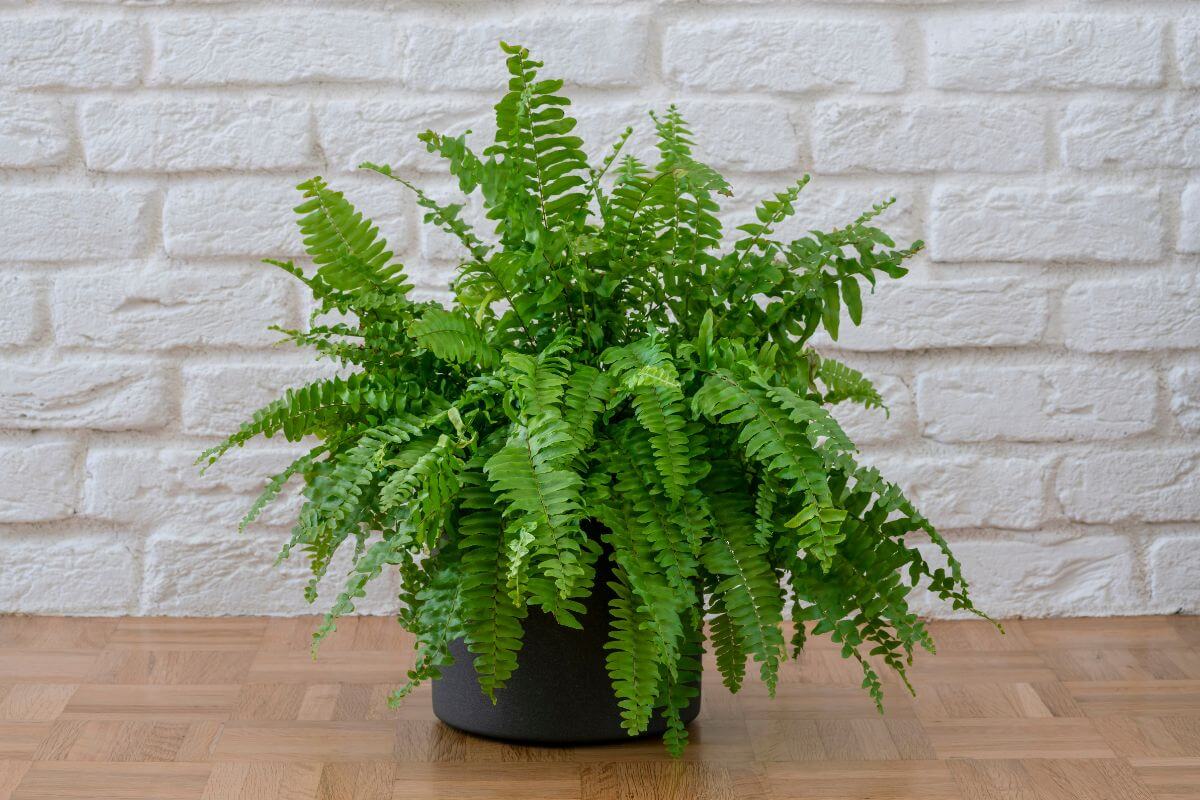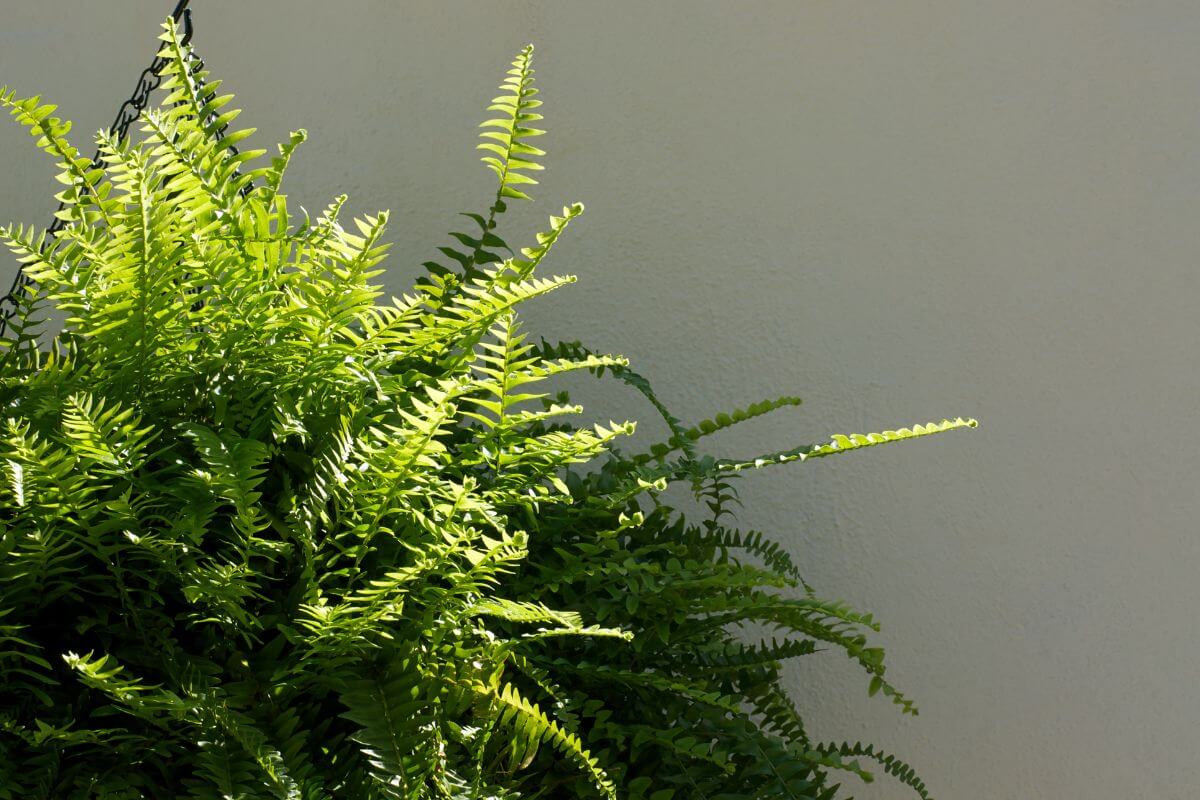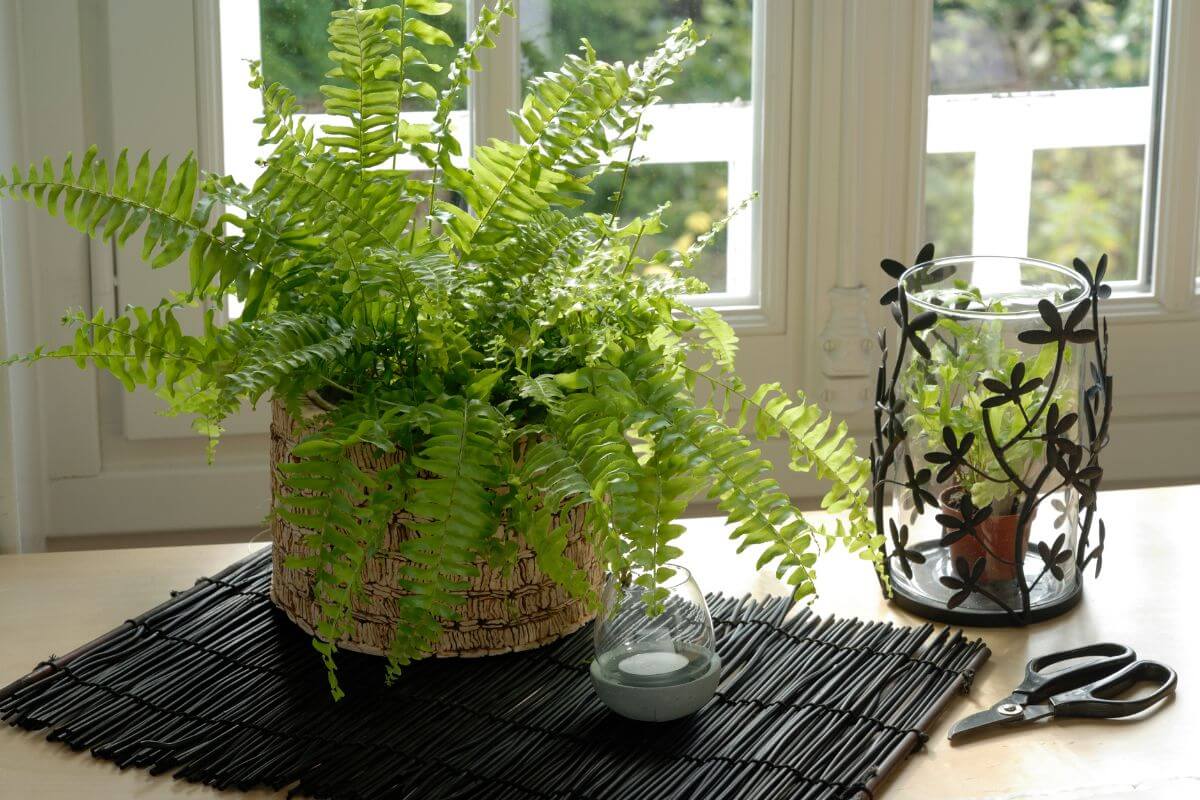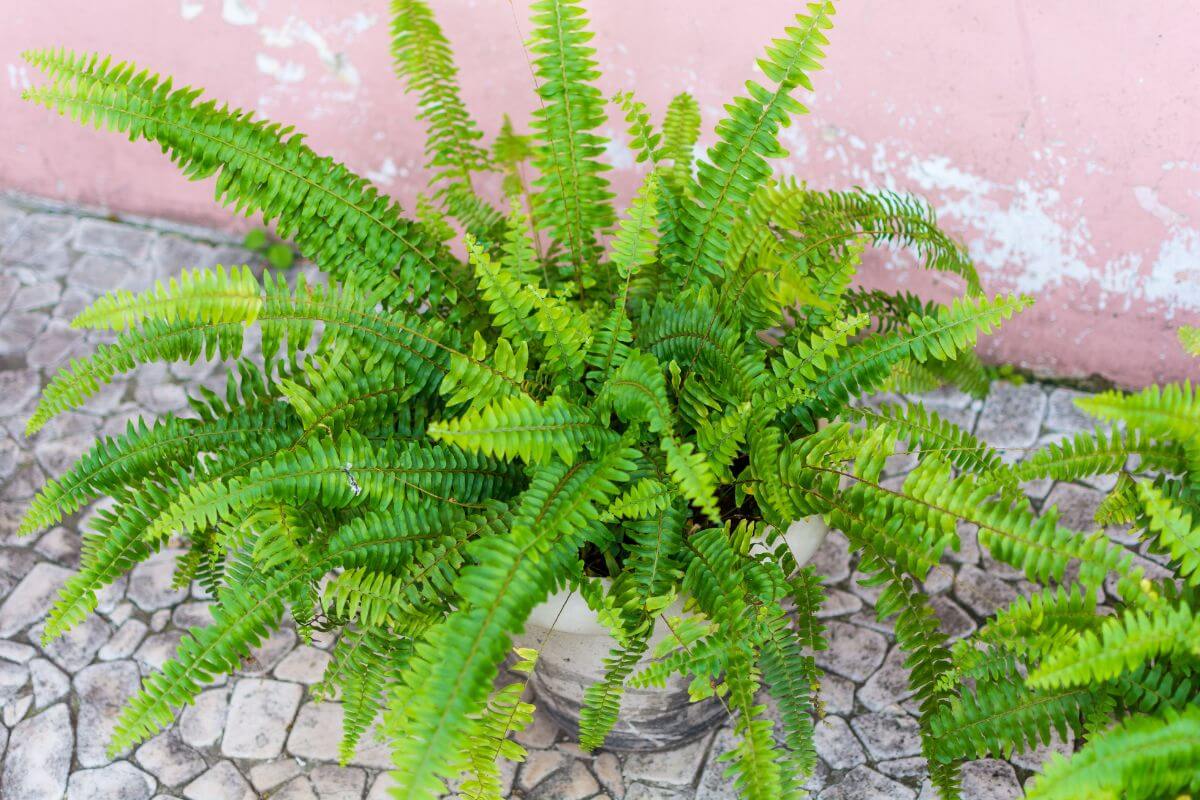The Boston Fern has become one of the most popular houseplants today for its lively, lush, green, happy appearance. These plants are still being grown today because of their beauty and versatility.
They can be found at any garden center or home improvement store. This houseplant requires little care but do need some light during the day.
Let’s get into the details of how to care for and grow the Boston Fern plant.
- Related article: Different Houseplants You Can Grow
5 Key Takeaways on the Boston Fern
- Boston ferns need high humidity levels to stay healthy and green.
- Keep the soil moist but avoid waterlogging to prevent root rot.
- Too much direct sunlight can scorch the fronds, while too little causes leaf drop.
- Boston ferns prefer temperatures between 65°F and 75°F, avoiding extreme heat or cold.
- Grow more ferns more easily by dividing the plant during repotting in the spring.
Overview of the Boston Fern

A member of the Dryopteridaceae family, the Boston Fern’s botanical name is the Nephrolepsis exaltata bostoniensis.
The Boston fern mutation was discovered in 1895 amid two hundred sword ferns by a florist near Boston. The Sword Fern species is native to Florida and the American tropics.
There are more than 200 varieties of the Boston Fern. Some popular ones include:
- Nephrolepsis exaltata “Compacta” – A short very compact fern.
- Nephrolepsis exaltata “Florida Ruffle” – A medium sized-fern with ruffled, feather-like fronds.
- Nephrolepsis exaltata ”Fluffy Duffy” – A very dense small fern with feathery fronds that boast a fine texture.
- Nephrolepsis exaltata “Golden Boston” – A fern with fronds that are yellow-green.
- Nephrolepsis exaltata “Rita’s Gold” – A compact fern with chartreuse-tinted fronds.
Boston Fern Care Guide
Boston ferns appreciate an extra bit of care. They like their environment to be humid and warm. They suffer when exposed to extreme temperatures when cultivated outside.
Indoor ferns need to be protected from drafts and should not be positioned near heating or air conditioning vents. These plants do best when in a stable environment.
Frequent watering is a must to keep the soil bed from drying out. They should be fed the entire growing season from spring to autumn. Humidity is also a necessity for your plant’s overall health.
Boston Fern Soil Requirements
Boston ferns thrive in well-draining, porous soil that retains moisture. A mix of peat moss, perlite, organic compost, and pine bark works best.
Keep the soil consistently moist, but avoid sogginess to prevent root rot. High humidity is also key, so misting or using a pebble tray can help.
The soil should be slightly acidic, and light fertilization during the growing season supports healthy growth. Avoid fertilizing in winter when the plant is dormant.
Boston Fern Light Requirements

Boston ferns like very bright, but indirect light. This makes outdoor or indoor spots with filtered sunlight or partial shade ideal for them. If they are in a very shaded area, their fronds may suffer in appearance.
Too much direct sunlight will burn their fronds. Whether you cultivate your fern indoors or outdoors, they should have access to bright light, but no direct exposure to the sun.
Too much sun will scorch the foliage, too little sun will cause the plant to drop its leaves.
Boston Fern Water and Humidity Requirements
Keep the soil consistently moist, but not soggy, to ensure your Boston fern stays healthy. Dry soil can lead to dried-out foliage that drops from the plant. In autumn and winter, reduce watering slightly, but monitor the fronds for dryness.
Boston ferns need high humidity, ideally 80% or more. If your space lacks humidity, consider using a humidifier or placing a pebble tray with water beneath the plant, keeping the pot above the waterline. Misting the leaves can also help.
If the tips of the fronds turn brown or yellow, it’s a sign of low humidity. Make sure to adjust humidity levels or move the plant to a more suitable environment, like a bathroom.
Boston Fern Temperature Requirements
A constant mild temperature between 65° and 75° Fahrenheit is ideal for the Boston fern. They do not tolerate extreme temperatures whether hot or cold.
Temperatures that rise to 95°F or above will harm your fern, as will temperatures that fall to 35°F and below.
Boston ferns can be left outdoors in the winter if you reside in an area that is subtropical, meaning without freezing temperatures or frost.
Boston Fern Fertilization Requirements
The Boston fern should be fed from spring to the beginning of autumn using a liquid fertilizer diluted to half strength on a monthly basis.
Foliage should be rinsed after fertilization to prevent burning the leaves. During the dormancy period from the middle of fall through the winter, they do not require fertilizing.
The use of an Epsom salt solution of two tablespoons per gallon of water, applied twice annually, will contribute to maintaining its vivid green color.
How to Prune and Repot the Boston Fern

To prune your Boston fern effectively, follow these steps:
- Check the leaves – Look for yellow or brown fronds and snip them at the base to encourage new growth. If you see runners without leaves hanging, it’s time for a trim.
- Radical pruning (optional) – For more drastic pruning, wait until spring or summer. Boston ferns respond well to this during their active growing season.
- Use clean scissors or pruning shears.
- Avoid trimming from the top. Instead, work from the sides and base to shape the plant.
- If needed, you can cut the fern all the way down to the base.
- Choose the right container – The pot should be about one inch larger than the root ball and have good drainage holes.
- Repotting – If you notice roots peeking out or the plant’s growth slows, it’s time to repot.
- Do this in spring.
- Gently remove the fern from its old pot, shake off some of the old soil, and place it in a new container with fresh soil.
These steps will keep your Boston fern healthy and thriving.
How to Propagate the Boston Fern
The Boston fern is easiest to propagate by crown division. When you repot in the spring, you can separate and cut a section of your mother plant, making sure that some roots remain attached.
You can do this by cutting both larger or smaller sections. Place your divided section in its own container with a fresh soil bed, and water. Keep the soil bed moist at all times, same as you would for a mature Boston fern.
Also keep your baby fern in a warm spot far from drafts, breezes, direct sunlight, and changes in temperature.
When you notice some resistance while pulling gently at the base of the fern, you will know that the roots have established themselves.
Is the Boston Fern Toxic to Pets?
Boston ferns are safe for both cats and dogs, making them a great option for homes with pets. While they aren’t harmful, eating the leaves may cause mild stomach upset like vomiting or diarrhea if pets consume a lot.
To avoid any issues, it’s best to keep pets from chewing on the fern and keep an eye on curious pets, especially younger ones. Overall, Boston ferns are a pet-friendly plant as long as owners take simple precautions.
Boston Fern Pests, Diseases, and Problems
While not particularly at risk for disease and pest infestations, Boston ferns are still susceptible to a few diseases and insects, in particular mealybugs and spider mites.
You can treat your fern to a good shower to help remove some pests and then apply an organic insecticidal soap or neem oil. It is important to treat the infestation immediately.
If foliage turns dark brown or black, it may be a sign that the soil bed has nematodes. In that case, add compost to the soil to encourage the development of fungi that are beneficial.
If the infestation is advanced, you should eliminate infected plants. Brown and black spots with a bad odor indicate bacterial soft rot and the plant should also be eliminated.
Leaf tip burn will manifest with brown withering frond tips. Rhizoctonia Blight manifests itself with brown or black spots near the plant’s crown that spread rapidly. In this instance, the fern needs to be sprayed with fungicide.
How to Grow Boston Fern Outdoors

Although usually grown as a houseplant, a Boston Fern can do exceptionally well outdoors if the climate is warm and humid. They can survive in dryer climates if sufficient water is provided.
The fern should be positioned in a location that offers partial to full shade. It will require water because it is not drought-tolerant. Mist your fern on very hot days.
When cultivated outside, your fern will be susceptible to visits from slugs. If there are only a few, you can remove them by hand.
Placing a coarse substance around the Boston fern will also dissuade slugs, such as coffee grounds, broken dry eggshells, or diatomaceous earth. You can use slug pellets but follow the product directions carefully.
Growing Boston Fern Final Thoughts
Caring for a Boston fern requires attention to humidity, light, and watering needs, but the rewards are worth it. Even though they can be a hard plant to grow, with proper care, your fern will grow vibrant and lush, adding a touch of natural beauty to any space.
Whether you’re a seasoned gardener or just starting out, these plants are a great addition to your indoor or outdoor garden.
Growing Boston Fern FAQs
1. How Much Sun Does the Boston Fern Need?
The Boston Fern likes bright indirect light. Direct sunlight can scorch the leaves, so be sure it gets some shade and filtered sunlight.
2. What Kind of Soil Mixture Works Best for My Boston Fern?
Use a potting mix rich in peat moss and perlite for the Boston Fern. This combination provides excellent water drainage and air circulation.
3. Is It Okay to Fertilize My Boston Fern?
Yes! Fertilizing the Boston Fern helps promote healthy growth and blooms. Use a balanced liquid fertilizer every month during the spring, summer, and early fall months.
4. Are Boston Ferns Hard to Care For?
Boston Ferns are easy to grow once they have been established. The key is providing adequate water, light, and nutrients throughout the growing season.
5. Can a Boston Fern Live Outside?
Yes, a Boston Fern can live outside as long as the climate is warm and humid. Be sure to monitor the soil regularly for moisture. Water the plants when the soil is dry. Be sure that there’s also shade, so there aren’t long exposures to direct sunlight that can scorch the leaves.
Discover more great houseplants by checking out these articles:







